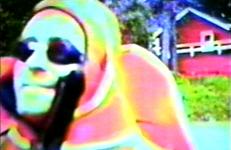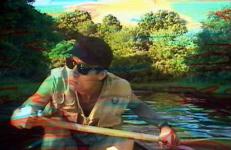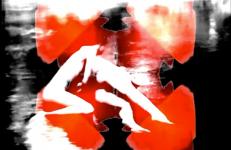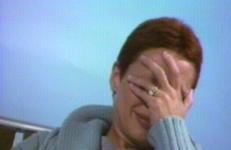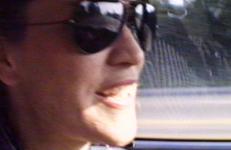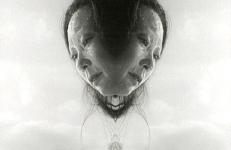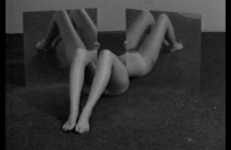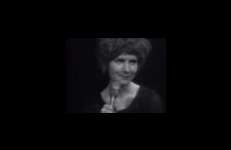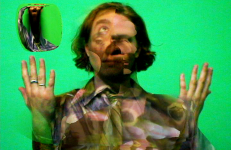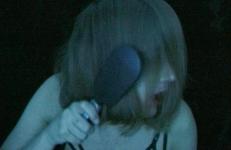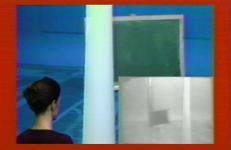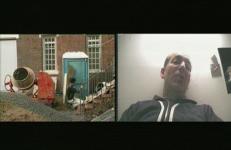A desktop video in five parts that modestly propose ways of existing with or against history and politics.
Performance
Hokey Sapp Does SPEW features Kate Schechter performing her invented media personality Hokey Sapp interviewing some of the luminaries at SPEW: The Homographic Convergence, a queer zine convention hosted by Randolph Street Gallery in Chicago in May, 1991. SPEW brought together artists, writers, editors of zines, performers, video-makers, activists, and bands from throughout the US and Canada, and marked the explosion of queercore subcultures through unabashed fashion, outrageous politics, humor, and joy.
Parnes moves further into her interrogation of horror genres and the art world, with their sometimes over-lapping cults of personality. Grappling with the danger of beauty without criticality, Hollywood Inferno takes the viewer through the alienating world of a teenager named Sandy, a modern-day Dante, and follows where her aspirations toward stardom lead her.
Klaus Nomi (born Klaus Sperber) was an underground superstar in the East Village arts scene in the 1970s and early 1980s. Known for his dramatic attire and make-up, and his theatrical stage presence, Nomi was a countertenor and could achieve a wide vocal range, allowing him to include operatic embellishments to his musical numbers. He died in 1983 and was one of the earliest artists to die from AIDS.
In Home Tape Revised, Benglis took a portable tape recorder with her when she visited her family in Louisiana. She saw most of the experience through the video camera, thus giving her a distance from an emotionally involving situation. The tapes were replayed and re-shot off a monitor and commented about by Benglis... It is a deeply personal tape about an emotionally involving situation, but it is precisely controlled.
A HalfLifers journey to a lush interior landscape where some domestic chores and an unexpected encounter provoke a crisis at Mission Control, paving the way for a seasonal reflection upon the meaning of "home."
This title is also available on HalfLifers: The Complete History.
This real-time video-meets-digital-animation trilogy of shorts features the highly excited and mildly delusional Joe Gibbons. As the phony, Gibbons recounts his influence among rock legends Iggy Pop and Brian Wilson. Brilliant superimposed computer animation by Emily Breer provides an additional layer of biting commentary.
Ana Mendieta performs a kiss in Old Man's Creek with another performer.
There is a crudeness to How's Tricks, Benglis's first venture into narrative fiction. No attempt is made to hide the mechanics of making the tape. At one point, while Benglis and [Stanton] Kaye argue about the tape they are making of [Bobby] Reynolds (a real-life carny who also appears in The Amazing Bow-Wow), Kaye is seen reaching over to turn off the video recorder — and thus the scene ends...
There is a crudeness to How's Tricks, Benglis's first venture into narrative fiction. No attempt is made to hide the mechanics of making the tape. At one point, while Benglis and [Stanton] Kaye argue about the tape they are making of [Bobby] Reynolds (a real-life carny who also appears in The Amazing Bow-Wow), Kaye is seen reaching over to turn off the video recorder — and thus the scene ends...
A three-day teleplay done at CalArts takes a sordid behind-the-scenes look at an art school professor’s life.
The plot of this colorful and episodic video drama concerns the gifted protégé of a war torn world who is granted a glimpse into the future by reading the imprinted impressions of human buttocks. At least that is what I think it is about. There are many loud sequences of inner and outer turmoil with pretty cast members being faithful to the weaving plot line as it spins its convoluted tale of exposed rear ends and dangling subplots. The pace is fast and painless as a parade of young people bring to life a story ripped from the pages of our most lurid, celebrity tabloids.
Having collaborated with videographers for previous media works, Eiko & Koma decided to work alone in creating Husk. Koma adopted the role of cameraman to film Eiko's solo piece. Eiko & Koma used the playback function of the video camera to create choreography for body and camera as one long take. This media dance is presented with no editing done in post-production. Sound design by Eiko. Filmed May, 1987 at the Kampo Cultural Center, New York, NY.
The performer interprets a video demonstration of a series of poses with mirrors, not unlike Breder's Bod/Sculpture photo series, but this time in a studio. This performance was later staged several times with Breder directing from off-camera.
Performed by Georgeanne Higgins.
A wonderfully witty work about nostalgia and desperation. Anne McGuire portrays a Kennedy-era singer performing in the space where theatre meets television. McGuire's Garland-esque gestures provide both a sense of tragedy and humor. I Am Crazy And You’re Not Wrong weaves narrative, performance, memory and history into an ironic and haunting work of singular proportions.
“A good example of Baldessari’s deadpan irreverence is the 1971 black-and-white video entitled I Am Making Art, in which he moves different parts of his body slightly while saying, after each move, ‘I am making art.’ The statement, he says, ‘hovers between assertion and belief.’ On one level, the piece spoofs the work of artists who, in the late 1960s and early 1970s, explored the use of their own bodies and gestures as an art medium.
Steve Seid of Pacific Film Archive calls it, “An episodic adventure about extra-evolutionary transformation. Organized as 'lesson plans’, this unique work is an ambitious tutorial for the neo-nauts of inner space."
This title is only available on Soft Science.
Steve Seid of Pacific Film Archive calls it, “An episodic adventure about extra-evolutionary transformation. Organized as 'lesson plans’, this unique work is an ambitious tutorial for the neo-nauts of inner space."
This title is only available on Soft Science.
In i am wise enough to die things go (2023), Syms explores the idea of psychosis through an unnamed protagonist reciting a monologue. Responding to the work of iconic animator Chuck Jones, Syms transfers the form and narrative structure of an animated short into live-action. Working with the inherent challenges and restrictions brought about by this sort of translation, she delves into both the breaking up of images and the breakdown of the psyche.
Eiko Otake’s I Invited Myself is a multi-volume installation which features choreography of place, movements of both performer and viewers, along with projections of selected video and film works created by Eiko over the last 40 years.
Unlike audiences to cinema, literature, music, and visual art works, the audience to contemporary performance work often experiences one newly created evening-length piece. Those audiences who saw the artist’s earlier works have an understanding of her trajectory, but younger or new audiences might not.
The title gives a bitter meaning to the uneasy image of a woman who is brushing her hair over her face with fierce movements. Mostly the face remains impersonally hidden under her hair; when it is uncovered, we see how the rough scratches of the brush against the skin have smeared her lipstick.
This title is also available on Hester Scheurwater Videoworks: Volume 1.
Jonas intercuts scenes of the Nova Scotia countryside with images of a studio set-up reminiscent of a di Chirico painting. The soundtrack includes both music and spoken excerpts from a journal Jonas kept while travelling in Nova Scotia. I Want to Live in the Country ultimately deals with observation and fantasy, living in the country, and the stifling aspects of the city and one's art.
This title was in the original Castelli-Sonnabend video art collection.
A comic monologue, I Was Once Involved in a Shit Show is a recollection of an imaginary art event that tallies with what most artists experience when they are involved in putting on an unfunded group show.
“‘I will not make any more boring art,’ John Baldessari wrote over and over again in a work done in 1971. The impulse for the piece, he says, came from dissatisfaction with the ‘fallout of minimalism,’ but its implications are far greater. It is typical of Baldessari’s work, for not only is it extremely funny, but it is also a strategy, a set of conditions, a directive, a paradoxical statement, and a commentary on the art world with which it is involved. Like all his work to date, it addresses, on many complex levels, issues about art, language, games and the world at large.”
I once read a story about the Tibetan Buddhist Master, Chogyam Trungpa Rimpoche in a book by death-teacher, Steven Levine. Trungpa went into his son's room and said to him, "I'm dying." And then he said to his son, "You are dying too." This story made a deep impression on me because death is the last taboo, the hidden boogey-man, the unspeakable. It was a beautiful lesson in impermanence this father gave his son.









